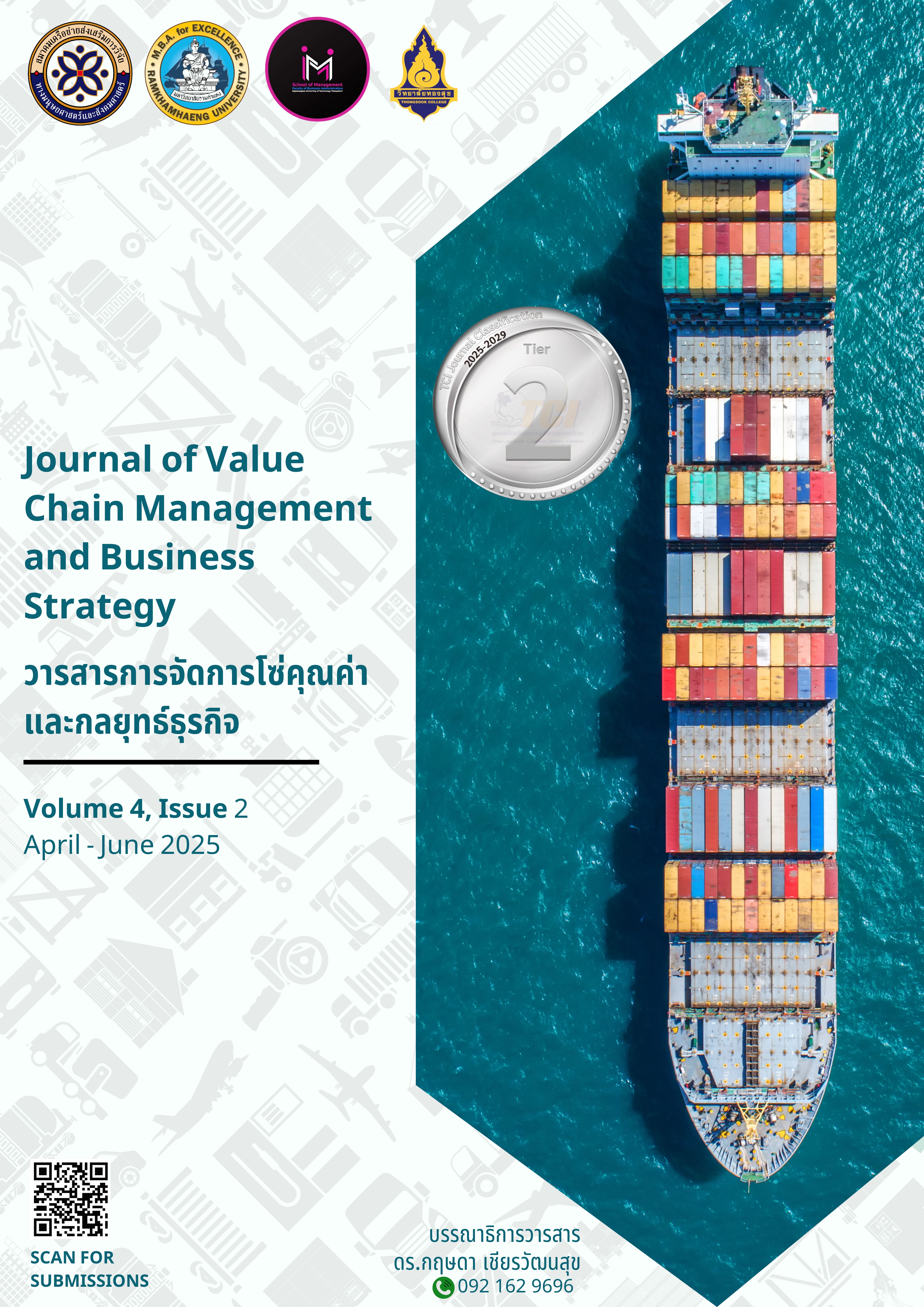อิทธิพลของความเชื่อมั่นในการให้บริการมีต่อความตั้งใจในการใช้งานแอปพลิเคชัน PEA Smart Plus: บทบาทตัวแปรส่งผ่านของการรับรู้ถึงความง่าย และประโยชน์ในการใช้งาน
คำสำคัญ:
ความเชื่อมั่นในผู้ให้บริการ, การรับรู้ถึงประโยชน์ในการใช้งาน, การรับรู้ถึงความง่ายในการใช้งาน, ความตั้งใจในการใช้งานบทคัดย่อ
การวิจัยครั้งนี้มีวัตถุประสงค์เพื่อศึกษาอิทธิพลของความเชื่อมั่นในผู้ให้บริการที่มีต่อความตั้งใจในการใช้งานแอปพลิเคชัน PEA Smart Plus โดยมีบทบาทการเป็นตัวแปรส่งผ่านของการรับรู้ถึงความง่ายในการใช้งานและการรับรู้ถึงประโยชน์ในการใช้งาน การวิจัยเรื่องนี้เป็นการวิจัยเชิงปริมาณ ใช้วิธีการสำรวจโดยใช้แบบสอบถามเป็นเครื่องมือในการเก็บข้อมูล กลุ่มตัวอย่าง คือ ผู้บริโภคที่ใช้งานแอปพลิเคชัน PEA Smart Plus จำนวน 385 คน สถิติเชิงพรรณนาที่ใช้ในการวิเคราะห์ข้อมูลเชิงปริมาณ ได้แก่ ค่าความถี่ ค่าร้อยละ ค่าเฉลี่ยและค่าส่วนเบี่ยงเบนมาตรฐาน สถิติเชิงอนุมานที่ใช้ในการทดสอบสมมติฐาน คือ ค่าสัมประสิทธิ์สหสัมพันธ์แบบเพียร์สัน และการวิเคราะห์ในรูปแบบของโมเดลสมการโครงสร้างแบบกำลังสองน้อยที่สุดบางส่วน (PLS-SEM)
ผลการวิจัยพบว่า ความเชื่อมั่นที่ผู้ใช้งานมีต่อผู้ให้บริการ ส่งผลเชิงบวกต่อความตั้งใจในการใช้งานและการรับรู้ถึงประโยชน์ของแอปพลิเคชันในระดับนัยสำคัญทางสถิติที่ระดับ .001 แต่ส่งผลลบต่อการรับรู้ถึงความง่ายในการใช้งานอย่างมีนัยสำคัญทางสถิติที่ระดับ .001 ขณะที่การรับรู้ถึงประโยชน์ในการใช้งานส่งผลบวกต่อความตั้งใจในการใช้งานและการรับรู้ถึงความง่ายในการใช้งานอย่างมีนัยสำคัญทางสถิติที่ระดับ .001 ส่วนการรับรู้ถึงความง่ายในการใช้งานส่งผลลบต่อความตั้งใจในการใช้งานอย่างมีนัยสำคัญทางสถิติที่ระดับ .01 ซึ่งขัดแย้งกับทฤษฎี TAM ดั้งเดิม ด้านอิทธิพลทางอ้อม ความเชื่อมั่นในผู้ให้บริการส่งผลต่อความตั้งใจในการใช้งานผ่านการรับรู้ถึงประโยชน์ในการใช้งานอย่างมีนัยสำคัญทางสถิติที่ระดับ0.001 ผ่านการรับรู้ถึงความง่ายในการใช้งานอย่างมีนัยสำคัญทางสถิติที่ระดับ .05 และผ่านทั้งการรับรู้ถึงประโยชน์และความง่ายในการใช้งานอย่างมีนัยสำคัญทางสถิติที่ระดับ .01 ผลงานวิจัยชี้ให้เห็นว่า ผู้ใช้งานให้ความสำคัญกับประโยชน์ที่ได้รับและความเชื่อมั่นในผู้ให้บริการมากกว่าความง่ายในการใช้งาน การพัฒนาแอปพลิเคชันบริการสาธารณะจึงควรเน้นการออกแบบฟังก์ชันที่มีประโยชน์และการสร้างความเชื่อมั่นในองค์กรเป็นสำคัญ
เอกสารอ้างอิง
Abdullah, F., & Ward, R. (2016). Developing a general extended technology acceptance model for e-learning (GETAMEL) by analyzing commonly used external factors. Computers in Human Behavior, 56, 238–256. https://doi.org/10.1016/j.chb.2015.11.036
Abdullah, M. S. B., Yajid, M. S. A. B., Khatibi, A., & Tham, J. (2022). Brand trust, perceived usefulness, perceived ease of use towards online purchase intention of mobile telecommunications services among smartphone users in Malaysia. NeuroQuantology, 20(17), 619–629. https://www.neuroquantology.com/media/article_pdfs/619-629.pdf
Adams, U. (2025). Digital transformation and its impact on business models. International Journal of Economics, Business and Management Research, 9(2), 132-142. https://doi.org/10.51505/IJEBMR.2025.9212
Alalwan, A. A., Dwivedi, Y. K., Rana, N. P., & Williams, M. D. (2017). Consumer adoption of mobile banking in Jordan: Examining the role of usefulness, ease of use, perceived risk and self-efficacy. Journal of Enterprise Information Management, 29(1), 118–139. https://doi.org/10.1108/JEIM-04-2015-0035
Alalwan, A. A., Dwivedi, Y. K., Rana, N. P., Lal, B., & Williams, M. D. (2015). Consumer adoption of Internet banking in Jordan: Examining the role of hedonic motivation, habit, self-efficacy and trust. Journal of Financial Services Marketing, 20, 145–157. https://doi.org/10.1057/fsm.2015.5
Anandarajan, M., Igbaria, M., & Anakwe, U. P. (2002). IT acceptance in a less-developed country: A motivational factor perspective. International Journal of Information Management, 22(1), 47–65. https://doi.org/10.1016/S0268-4012(01)00040-8
Baabdullah, A. M. (2018). Consumer adoption of mobile social network games (m-SNGs) in Saudi Arabia: The role of social influence, hedonic motivation and trust. Technology in Society, 53, 91–102. https://doi.org/10.1016/j.techsoc.2018.01.004
Bagozzi, R. P., & Yi, Y. (1988). On the evaluation of structural equation models. Journal of the Academy of Marketing Science, 16(1), 74-94. https://doi.org/10.1007/BF02723327
Bagozzi, R. P., & Yi, Y. (2012). Specification, evaluation, and interpretation of structural equation models. Journal of the Academy of Marketing Science, 40(1), 8-34. https://doi.org/10.1007/s11747-011-0278-x
Baron, R. M., & Kenny, D. A. (1986). The moderator-mediator variable distinction in social psychological research: Conceptual, strategic, and statistical considerations. Journal of Personality and Social Psychology, 51(6), 1173-1182 https://doi.org/10.1037/0022-3514.51.6.1173
Berisca, A., Clive, S., Hardani, J., & Hutabarat, A. S. (2024). Development of the TAM model of factors that influence the acceptance of mobile payments. Jurnal Ilmiah Manajemen Ekonomi dan Akuntansi, 8(2), 42-66. https://doi.org/10.31955/mea.v8i2.3967
Berisha-Shaqiri, A. (2015). Impact of information technology and internet in businesses. Academic Journal of Business Administration, Law and Social Sciences, 1(1), 73-79.
Bhattacherjee, A. (2001). Understanding information systems continuance: An expectation-confirmation model. MIS Quarterly, 25(3), 351–370. https://doi.org/10.2307/3250921
Bouhlel, O., & Mzoughi, M. N. (2024). An investigation of users’ continuance intention toward mobile banking applications. International Journal of Business, 29(1), Article 005. https://doi.org/10.55802/IJB.029(1).005
Cai, Z., Fan, X., & Du, J. (2017). Gender and attitudes toward technology use: A meta-analysis. Computers & Education, 105, 1–13. https://doi.org/10.1016/j.compedu.2016.11.003
Cheng, P., & Zhao, X. (2025). Trust development and user value perception in service platforms: An empirical study. Journal of Service Management and Innovation, 33(1), 25–47.
Cochran, W. G. (1953). Sampling techniques. John Wiley & Sons.
Davis, F. D. (1989). Perceived usefulness, perceived ease of use, and user acceptance of information technology. MIS Quarterly, 13(3), 319–340. https://doi.org/10.2307/249008
Diaz‑Guzmán, M., Medina‑Quintero, J.‑M., & Ortiz‑Rodriguez, F. (2025). Perceived usefulness and ease of use of e‑government to generate trust and intention to use by citizens. Journal of Technology Management & Innovation, 20(1), 49–60. https://doi.org/10.4067/S0718-27242025000100049
Dwivedi, Y. K., Hughes, D. L., Coombs, C., Constantiou, I., Duan, Y., Edwards, J. S., & Upadhyay, N. (2020). Impact of COVID-19 pandemic on information management research and practice: Transforming education, work and life. International Journal of Information Management, 55, 102211. https://doi.org/10.1016/j.ijinfomgt.2020.102211
Eappen, N. J. (2019). Mobile wallet adoption in India: Impact of trust and information sharing. South Asian Journal of Management, 26(1), 32-49.
Eriksson, K., Kerem, K., & Nilsson, D. (2005). Customer acceptance of internet banking in Estonia. International Journal of Bank Marketing, 23(2), 200–216. https://doi.org/10.1108/02652320510584412
Fornell, C., & Larcker, D. F. (1981). Structural Equation Models with Unobservable Variables and Measurement Error: Algebra and Statistics. Journal of Marketing Research, 18(3), 382-388. https://doi.org/10.2307/3150980
Gefen, D., Karahanna, E., & Straub, D. W. (2003). Trust and TAM in online shopping: An integrated model. MIS Quarterly, 27(1), 51–90. https://doi.org/10.2307/30036519
Gholami, R., Watson, R. T., Hasan, H., Molla, A., & Bjorn-Andersen, N. (2016). Information systems solutions for environmental sustainability: How can we do more?. Journal of the Association for Information Systems, 17(8), 521–536. https://doi.org/10.17705/1jais.00435
Gursoy, D., Chi, C. G., Lu, L., & Nunkoo, R. (2019). Consumers’ acceptance of artificially intelligent (AI) device use in service delivery. International Journal of Information Management, 49, 157–169. https://doi.org/10.1016/j.ijinfomgt.2019.03.008
Hair Jr., J. F., Howard, M. C., & Nitzl, C. (2020). Assessing measurement model quality in PLS-SEM using confirmatory composite analysis. Journal of Business Research, 109, 101–110. https://doi.org/10.1016/j.jbusres.2019.11.069
Hanafizadeh, P., Behboudi, M., Koshksaray, A. A., & Tabar, M. J. S. (2014). Mobile-banking adoption by Iranian bank clients. Telematics and Informatics, 31(1), 62–78. https://doi.org/10.1016/j.tele.2012.11.001
Jiang, X., Goh, T.-T., & Liu, M. (2022). On students’ willingness to use online learning: A privacy calculus theory approach. Frontiers in Psychology, 13, Article 880261. https://doi.org/10.3389/fpsyg.2022.880261
Kim, J., & Park, H. A. (2012). Development of a health information technology acceptance model using consumers’ health behavior intention. Journal of Medical Internet Research, 14(5), e133. https://doi.org/10.2196/jmir.2143
Luo, X., Li, H., Zhang, J., & Shim, J. P. (2010). Examining multi-dimensional trust and multi-faceted risk in initial acceptance of emerging technologies: An empirical study of mobile banking services. Decision Support Systems, 49(2), 222–234. https://doi.org/10.1016/j.dss.2010.02.008
Mahwadha, W. I. (2019). Behavioral intention of young consumers towards e-wallet adoption: An empirical study among Indonesian users. Russian Journal of Agricultural and Socio-Economic Sciences, 85(1), 79-93. http://doi.org/10.18551/rjoas.2019-01.09
Marriott, H. R., & Williams, M. D. (2018). Exploring consumers perceived risk and trust for mobile shopping: A theoretical framework and empirical study. Journal of Retailing and Consumer Services, 42, 133–146. https://doi.org/10.1016/j.jretconser.2018.01.017
Nezamdoust, S., Abdekhoda, M., & Rahmani, A. (2022). Determinant factors in adopting mobile health application in healthcare by nurses. BMC Medical Informatics and Decision Making, 22(47). https://doi.org/10.1186/s12911-022-01784-y
Nihayah, N., & Purnama, N. B. (2024). Evaluation Of Digital Banking Application Adoption Based on The Technology Acceptance Model (Tam). International Journal of Science, Technology & Management, 5(2), 424-430.
Nunnally, J. C., & Bernstein, I. H. (1994). Psychometric theory. McGraw-Hill.
Oamen, T. E. (2023). Technology acceptance model (TAM) for pharmaceutical marketing executives: Validation and implications for human resource management. Jurnal Aplikasi Manajemen, 21(4), 876-891. https://doi.org/10.21776/ub.jam.2023.021.04.02
Panergayo, A. A., & Aliazas, J. V. (2021). Students' behavioral intention to use learning management system: The mediating role of perceived usefulness and ease of use. International Journal of Information and Education Technology, 11(11), 538–545.
Peterson, R. A. (2000). A meta-analysis of variance accounted for and factor loadings in exploratory factor analysis. Marketing Letters, 11, 261-275. https://doi.org/10.1023/A:1008191211004
Rahimi, B., Nadri, H., Lotfnezhad Afshar, H., & Timpka, T. (2018). A systematic review of the technology acceptance model in health informatics. Applied Clinical Informatics, 9(3), 604–634. https://doi.org/10.1055/s-0038-1668091
Riffai, M. M. M. A., Grant, K., & Edgar, D. (2012). Big TAM in Oman: Exploring the promise of on-line banking, its adoption by customers and the challenges of banking in Oman. International Journal of Information Management, 32(3), 239–250. https://doi.org/10.1016/j.ijinfomgt.2011.11.007
Roca, J. C., García, J. J., & De La Vega, J. J. (2009). The importance of perceived trust, security and privacy in online trading systems. Information Management & Computer Security, 17(2), 96-113. https://doi.org/10.1108/09685220910963983
Salhoub, M., Maatuk, A. M., & Elaish, M. M. (2022). An enhanced TAM model for measuring the usability of electronic services. In 2022 International Conference on Engineering & MIS (ICEMIS) (pp. 1-5). IEEE. http://doi.org/10.1109/ICEMIS56295.2022.9914098
Salloum, S. A., Al-Emran, M., Shaalan, K., & Tarhini, A. (2019). Factors affecting the e-learning acceptance: A case study from UAE. Education and Information Technologies, 24, 509-530. https://doi.org/10.1007/s10639-018-9786-3
Seridaran, S., Sithamparam, A. G., Falahat, M., & Ekmekcioğlu, Ö. (2024). Determinants of continuance usage intentions: The mediating role of satisfaction and trust in branded mobile applications among Malaysians. Cogent Business & Management, 11(1), 2402082. https://doi.org/10.1080/23311975.2024.2402082
Shao, Z., Zhang, L., Li, X., & Guo, Y. (2019). Antecedents of trust and continuance intention in mobile payment platforms: The moderating effect of gender. Electronic Commerce Research and Applications, 33, 100823. https://doi.org/10.1016/j.elerap.2018.100823
Sharma, S., & Sharma, A. (2024). Insights into customer engagement in a mobile app context: Review and research agenda. Cogent Business & Management, 11(1), 2382922. https://doi.org/10.1080/23311975.2024.2382922
Sriboonlue. O. (2024). Factors affecting intention to use National Single Window (NSW) through perceived ease of use and perceived usefulness in import, export, and logistics enterprises. RMUTT Global Business Accounting and Finance Review, 8(1), 1-15. https://doi.org/10.60101/gbafr.2024.272386
Stocchi, L., Michaelidou, N., Pourazad, N., & Micevski, M. (2018). The rules of engagement: how to motivate consumers to engage with branded mobile apps. Journal of Marketing Management, 34 (13–14), 1196–1226. https://doi.org/10.1080/0267257X.2018.1544167
Tang, T., Wang, X., Wu, J., Yuan, M., Guo, Y., & Xu, X. (2023). Determinants and the moderating effects of individual characteristics on autonomous vehicle adoption in China. International Journal of Environmental Research and Public Health, 20(1), 43. https://doi.org/10.3390/ijerph20010043
Tippins, M. J., & Sohi, R. S. (2003). IT competency and firm performance: Is organizational learning a missing link? Strategic Management Journal, 24(8), 745-761. https://doi.org/10.1002/smj.337
Tubaishat, A. (2017). Perceived usefulness and perceived ease of use of electronic health records among nurses: Application of Technology Acceptance Model. Informatics for Health & Social Care, 43(4), 379–389. https://doi.org/10.1080/17538157.2017.1363761
Venkatesh, V., & Davis, F. D. (2000). A theoretical extension of the technology acceptance model: Four longitudinal field studies. Management Science, 46(2), 186–204. https://doi.org/10.1287/mnsc.46.2.186.11926
Venkatesh, V., Morris, M. G., Davis, G. B., & Davis, F. D. (2003). User acceptance of information technology: Toward a unified view. MIS Quarterly, 27(3), 425–478. https://doi.org/10.2307/30036540
Verhoef, P. C., Broekhuizen, T., Bart, Y., Bhattacharya, A., Qi Dong, J., Fabian, N., & Haenlein, M. (2021). Digital transformation: A multidisciplinary reflection and research agenda. Journal of Business Research, 122, 889–901. https://doi.org/10.1016/j.jbusres.2019.09.022
Vial, G. (2019). Understanding digital transformation: A review and a research agenda. The Journal of Strategic Information Systems, 28(2), 118–144. https://doi.org/10.1016/j.jsis.2019.01.003
Yudiantara, P. O., & Widagda, I. G. N. J. A. (2022). The role of trust in mediating the effect of perceived usefulness and perceived ease of use on decisions to use the LinkAja digital wallet: Study on LinkAja application users in Denpasar City. International Journal of Health Sciences, 6(S4), 6310–6327. https://doi.org/10.53730/ijhs.v6nS4.11176
Zhao, Y., Ni, Q., & Zhou, R. (2018). What factors influence the mobile health service adoption? A meta-analysis and the moderating role of age. International Journal of Information Management, 43, 342–350. https://doi.org/10.1016/j.ijinfomgt.2017.08.006
Zhou, T. (2012). Examining mobile banking user adoption from the perspectives of trust and flow experience. Information Technology and Management, 13(1), 27–37. https://doi.org/10.1007/s10799-011-0111-8
ดาวน์โหลด
เผยแพร่แล้ว
รูปแบบการอ้างอิง
ฉบับ
ประเภทบทความ
สัญญาอนุญาต
ลิขสิทธิ์ (c) 2025 วารสารการจัดการโซ่คุณค่าและกลยุทธ์ธุรกิจ

อนุญาตภายใต้เงื่อนไข Creative Commons Attribution-NonCommercial-NoDerivatives 4.0 International License.




